Smoke on the horizon – Israel and Hezbollah edge closer to all-out war
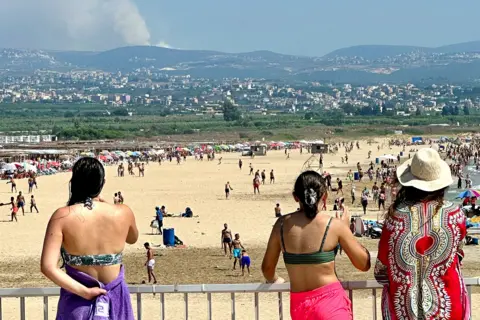 BBC / Goktay Koraltan
BBC / Goktay KoraltanAs the war in Gaza grinds on, there are growing fears another Middle East war may erupt – with devastating consequences for the region, and beyond.
Israel and the Lebanese armed group Hezbollah (backed by Iran) have been trading fire across their shared border for the past nine months. If this conflict escalates to all-out war, it could dwarf the destruction in Gaza, draw in Iranian-backed militias in Iraq, and Yemen, spread embers around the Middle East and embroil the US. Iran itself could intervene directly.
The United Nations has warned of a “catastrophe beyond imagination”.
For now, a low-level war simmers in the summer heat, along a 120km (75 mile) stretch of border. One spark here could set the Middle East alight.

Over the lapping of the waves, and the thwack thwack of paddle games on the beach, a sound cuts through – a sudden deep boom.
Soon smoke billows from a hillside in the distance after an Israeli strike.
Around the pool in a resort hotel, a few sunbathers stand briefly to scan the horizon.
Others don’t move a tanned limb.
Explosions are part of the sound of summer 2024 in the ancient Lebanese city of Tyre, as Hezbollah and Israel exchange fire across the border 25 kilometres (15 miles) away.
“Another day, another bomb,” says Roland, 49, with a shrug, as he relaxes on a lilo. He lives abroad but is back home on holiday.
“We got used to it somehow over the months,” says his friend Mustafa, 39, “though children are still a little bit scared.” He nods towards his daughter Miral, 7, who is dripping wet from the pool.
“When she hears an explosion, she always asks, ‘will there be a bomb now?’” he says.
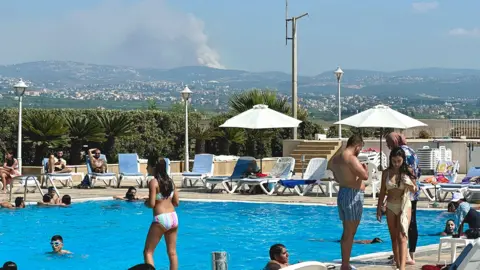 BBC / Goktay Koraltan
BBC / Goktay KoraltanEarlier this month, there was a massive blast in his neighbourhood in Tyre, as his family of four were having a meal. Israel had assassinated a senior Hezbollah commander, Mohammed Nimah Nasser.
“We heard the noise,” Mustafa says, “and we carried on eating.”
But the sunbathers on the beach in Tyre may be on borrowed time. This city will be in the firing line in the event of all-out war, along with the rest of southern Lebanon, a Hezbollah stronghold.
We are now at the water’s edge of a potentially devastating war which both sides say they don’t want.
How did we get here?
The conflict is heating up
On 8 October last year – one day after Hamas gunmen stormed out of Gaza and killed about 1,200 Israelis as well as taking 251 others hostage – Hezbollah joined in, firing from Lebanon into Israel.
The Shia Islamist armed group said it was acting in support of Gaza.
Soon Israel was firing back.
Hezbollah, which is also a political party, is the most powerful force in Lebanon.
Like Hamas, it is classed as a terrorist organisation by many countries, including the UK and the US.
But unlike Hamas, Hezbollah has the firepower to seriously threaten Israel.
It is believed to have an arsenal of more than 150,000 rockets and missiles – some precision-guided – capable of inflicting heavy damage around the country.
Put simply Hezbollah – its English translation, the Party of God – has more arms than many countries.
Its backer Iran – which denies Israel’s right to exist – is happy to train and fund the enemies of the Jewish state.
The conflict has been heating up, with thousands of cross-border strikes.
Some countries have already told their nationals to leave Lebanon urgently, including Germany, the Netherlands, Canada and Saudi Arabia. The UK has advised against all travel to the country and is urging Britons who are here to leave – while they still can.
So far, both sides are mainly striking military targets, close to the border – staying within familiar red lines.
 BBC / Goktay Koraltan
BBC / Goktay KoraltanBut here on the Lebanese side, we have seen destruction in civilian areas with scorched fields, flattened houses and abandoned villages.
And the current tit-for-tat has already driven tens of thousands from their homes – more than 90,000 in Lebanon and about 60,000 in Israel.
The Israeli army says Hezbollah has killed 21 of its soldiers. The civilian death toll is 12, according to government officials.
Lebanon’s losses are far higher at 466, according to the Ministry of Health here. Hezbollah says most of the dead were fighters.
Sally Skaiki was not.
‘We can’t forgive them’
“I never called her Sally,” says her father Hussein Abdul Hassan Skaiki. “I always called her ‘my life’ – she was everything for me.”
“She was the only girl in the house, and we spoiled her, me and her three brothers.”
Sally, 25, was a volunteer paramedic. She was killed by an Israeli strike after sunset on 14 June as she stood in the doorway of her building.
Her father wears the black of mourning, and the green scarf of the Shia Amal movement, which is allied to Hezbollah.
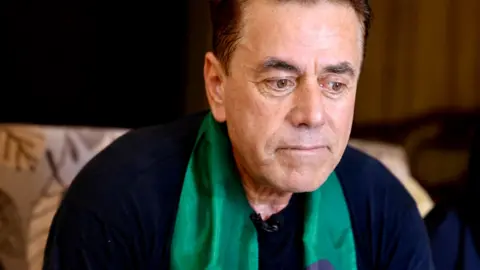 BBC / Goktay Koraltan
BBC / Goktay KoraltanWe meet in his village of Deir Qanoun En-Naher, 30km (18 miles) from the border. The main road is dotted with sun-bleached posters of fighters killed in battle against Israel – some in recent months, others back in 2006 when the two sides last went to war.
In that conflict, Hezbollah fought Israel to a standstill but at huge cost to Lebanon and its people. There was massive destruction, and more than 1,000 Lebanese civilians were killed – according to official figures – along with an unconfirmed number of Hezbollah fighters.
Israel’s death toll was 160, according to the government, most of them soldiers.
By Hussein’s side there is a large poster of Sally, in her headscarf and paramedic uniform. He speaks of his daughter with pride and with anguish.
“She loved to help people,” he says. “Any problem that happened, she rushed there. She was well-loved in the village. She always had a smile on her face.”
As we speak there is a loud boom which rattles the windows.
Hussein says it is a normal, daily occurrence.
“Since a long time, Israel killed our people here,” he says.
“We can’t forgive them. There is no hope of peace with them.”
This time, there is no death or destruction. Instead, Israeli warplanes are breaking the sound barrier to spread fear.
And, since October, Israel has been spreading something else in southern Lebanon – choking, searing clumps of white phosphorus, contained in munitions.
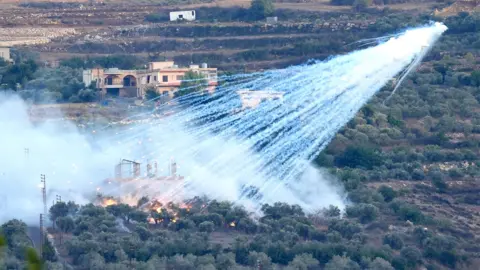 AP
APThe chemical substance ignites immediately on contact with oxygen. It sticks to skin and clothing and can burn through bone, according to the World Health Organization.
Moussa al-Moussa – a farmer stooped by his 77 years – knows only too well.
He says Israel fired white phosphorous shells at his land in the village of al-Bustan every day for over a month, robbing him of breath, and his livelihood.
“I had my scarf on, and I wrapped it around my mouth and nose until I was brought to the hospital,” he tells me, gesturing to the red and white keffiyeh – the traditional Arab scarf – on his head.
“We didn’t have any masks. I couldn’t breathe. I couldn’t see a metre in front of me. And if you touch a fragment a week later it will ignite and burn again.”
The international campaign group, Human Rights Watch, has verified the use of white phosphorus over several populated areas in southern Lebanon, including al-Bustan.
It says Israel’s use of white phosphorus is “unlawfully indiscriminate in populated areas”.
The Israel Defense Forces (IDF) dispute this, saying the use of white phosphorus shells to create a smokescreen “is lawful under international law”. It says these shells are not used in densely populated areas “with certain exceptions”.
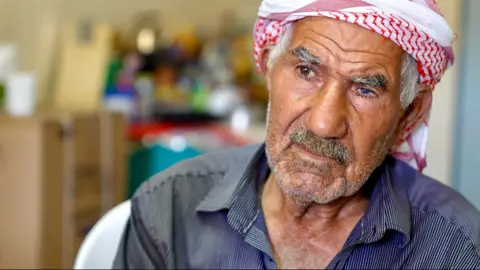 BBC / Goktay Koraltan
BBC / Goktay KoraltanLike many farmers along the border, Moussa fears Israel has poisoned his tobacco crop and his olive groves.
“White phosphorous burns the ground, it burns people and the crops and buildings,” he says.
Even if he can return home, he is afraid to bring in a harvest in case it harms his family or his buyers.
He lives in limbo – in classroom 4B of a vocational school in Tyre. About 30 families who fled the border area are sheltering in the building. Washing is strung across the school yard. A lone little boy races up and down the empty corridors on a bicycle.
When I ask Moussa how many wars he has seen, he begins to laugh.
“We spent our lives in wars,” he says. “Only God knows if another one is coming.”
‘We are not afraid’
As one of Hezbollah’s most senior commanders, Mohammed Nimah Nasser, was a wanted man. He fought Israel in 2006, and before, and went on to fight in Syria and Iraq. In recent months he “planned, led and supervised many military operations against the Israeli enemy”, according to Hezbollah.
Israel tracked him down in Tyre on 3 July. Death came from the sky in broad daylight, with an air strike which turned his car into a fireball.
In the Hezbollah stronghold of south Beirut, he was given a hero’s funeral, or rather a “martyr’s” one.
The event was carefully choreographed and strictly segregated – men in one area, women in another – including the press.
His coffin, draped in the yellow flag of Hezbollah, was carried by pall bearers in camouflage uniforms and red berets. Many more fighters stood to attention, lines deep. There was a brass band in spotless white uniforms, if not in perfect harmony.
It had the feel of a state funeral – in a country that lacks a functioning state.
Lebanon has no president, a caretaker government and a shattered economy. It is carved up by sect, and hollowed out by corruption, its citizens left to fend for themselves. Many Lebanese are weary. The last thing they want is another war.
Hezbollah sees things different.
As the funeral prayers concluded, the talk among mourners was of “martyrdom” not death, and of readiness for war, if it comes.
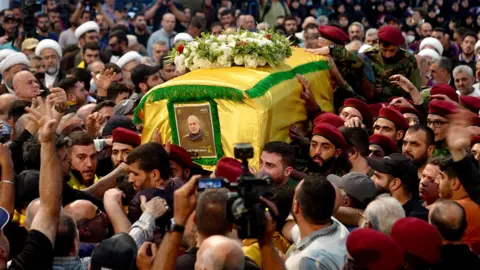 BBC / Goktay Koraltan
BBC / Goktay KoraltanHassan Hamieh, a 35-year-old nurse, told us he would fight. “We are not afraid,” he said.
“In fact, we are longing for an all-out war. Martyrdom is the shortest path to God. Young or old, we will all take part in this war, if it is forced upon us.”
Hezbollah’s leader, Hassan Nasrallah, has stressed the armed group is ready, but not eager, for war. He says if there is a ceasefire agreed in Gaza, Hezbollah will cease fire too, immediately.
Will that satisfy Israel? Maybe not.
It sees Hezbollah as a permanent threat too close for comfort. At the very least, it wants its heavily armed enemy to pull back from the border.
There have been plenty of bellicose threats. Israel’s Education Minister, Yoav Kish, said Lebanon would be “annihilated”. Defence Minister Yoav Gallant chimed in, saying the country would be returned “to the stone age”.
The IDF approved “operational plans for an offensive in Lebanon” a month ago.
For now, no tanks are rolling over the border. There has been no political decision to attack. Israel is still waging war in Gaza and fighting on two fronts could overstretch the military.
But without a diplomatic solution between Israel and Hezbollah – two old enemies – all-out war may be coming, if not now, then later.
Additional reporting by Goktay Koraltan and Ghassan Ibraheem






